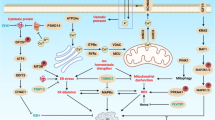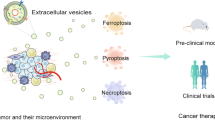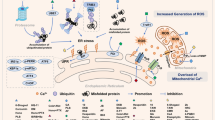Abstract
Selectivity toward cancer cells is the most desirable element in cancer therapeutics. Par-4 is a cancer cell-selective proapoptotic protein that functions intracellularly in the cytoplasmic and nuclear compartments as a tumor suppressor. Moreover, recent findings indicate that the Par-4 protein is secreted by cells, and extracellular Par-4 induces cancer cell-specific apoptosis by interaction with the cell-surface receptor GRP78. This review describes the mechanisms underlying the apoptotic effects of both extracellular and intracellular Par-4 acting through its effector domain SAC.
This is a preview of subscription content, access via your institution
Access options
Subscribe to this journal
Receive 50 print issues and online access
$259.00 per year
only $5.18 per issue
Buy this article
- Purchase on Springer Link
- Instant access to full article PDF
Prices may be subject to local taxes which are calculated during checkout

Similar content being viewed by others
References
Ahmed MM, Sheldon D, Fruitwala MA, Venkatasubbarao K, Lee EY, Gupta S et al. (2008). Downregulation of PAR-4, a pro-apoptotic gene, in pancreatic tumors harboring K-ras mutation. Int J Cancer 122: 63–70.
Almoguera C, Shibata D, Forrester K, Martin J, Arnheim N, Perucho M . (1988). Most human carcinomas of the exocrine pancreas contain mutant c-K-ras genes. Cell 53: 549–554.
Barkett M, Gilmore TD . (1999). Control of apoptosis by Rel/NF-kappaB transcription factors. Oncogene 18: 6910–6924.
Barradas M, Monjas A, Diaz-Meco MT, Serrano M, Moscat J . (1999). The downregulation of the pro-apoptotic protein Par-4 is critical for Ras-induced survival and tumor progression. EMBO J 18: 6362–6369.
Boghaert ER, Sells SF, Walid AJ, Malone P, Williams NM, Weinstein MH et al. (1997). Immuno-histochemical analysis of the proapoptotic protein Par-4 in normal rat tissues. Cell Growth Differ 8: 881–890.
Boosen M, Vetterkind S, Kubicek J, Scheidtmann KH, Illenberger S, Preuss U . (2009). Par-4 is an essential downstream target of DAP-like kinase (Dlk) in Dlk/Par-4-mediated apoptosis. Mol Biol Cell 20: 4010–4020.
Bos JL . (1989). ras oncogenes in human cancer: a review. Cancer Res 49: 4682–4689.
Burikhanov R, Zhao Y, Goswami A, Qiu S, Schwarze SR, Rangnekar VM . (2009). The tumor suppressor Par-4 activates an extrinsic pathway for apoptosis. Cell 138: 377–388.
Chakraborty M, Qiu SG, Vasudevan KM, Rangnekar VM . (2001). Par-4 drives trafficking and activation of Fas and Fasl to induce prostate cancer cell apoptosis and tumor regression. Cancer Res 61: 7255–7263.
Cook J, Krishnan S, Ananth S, Sells SF, Shi Y, Walther MM et al. (1999). Decreased expression of the pro-apoptotic protein Par-4 in renal cell carcinoma. Oncogene 18: 1205–1208.
Davidson DJ, Haskell C, Majest S, Kherzai A, Egan DA, Walter KA et al. (2005). Kringle 5 of human plasminogen induces apoptosis of endothelial and tumor cells through surface-expressed glucose-regulated protein 78. Cancer Res 65: 4663–4672.
Diaz-Meco MT, Municio MM, Frutos S, Sanchez P, Lozano J, Sanz L et al. (1996). The product of par-4, a gene induced during apoptosis, interacts selectively with the atypical isoforms of protein kinase C. Cell 86: 777–786.
Diaz-Meco MT, Lallena MJ, Monjas A, Frutos S, Moscat J . (1999). Inactivation of the inhibitory kappaB protein kinase/nuclear factor kappaB pathway by Par-4 expression potentiates tumor necrosis factor alpha-induced apoptosis. J Biol Chem 274: 19606–19612.
El-Guendy N, Rangnekar VM . (2003). Apoptosis by Par-4 in cancer and neurodegenerative diseases. Exp Cell Res 283: 51–66.
El-Guendy N, Zhao Y, Gurumurthy S, Burikhanov R, Rangnekar VM . (2003). Identification of a unique core domain of par-4 sufficient for selective apoptosis induction in cancer cells. Mol Cell Biol 23: 5516–5525.
Fujiwara T, Oda K, Yokota S, Takatsuki A, Ikehara Y . (1988). Brefeldin A causes disassembly of the Golgi complex and accumulation of secretory proteins in the endoplasmic reticulum. J Biol Chem 263: 18545–18552.
Garcia-Cao I, Duran A, Collado M, Carrascosa MJ, Martin-Caballero J, Flores JM et al. (2005). Tumour-suppression activity of the proapoptotic regulator Par4. EMBO Rep 6: 577–583.
Goswami A, Burikhanov R, de Thonel A, Fujita N, Goswami M, Zhao Y et al. (2005). Binding and phosphorylation of par-4 by akt is essential for cancer cell survival. Mol Cell 20: 33–44.
Gurumurthy S, Goswami A, Vasudevan KM, Rangnekar VM . (2005). Phosphorylation of Par-4 by protein kinase A is critical for apoptosis. Mol Cell Biol 25: 1146–1161.
Inesi G, Wade R, Rogers T . (1998). The sarcoplasmic reticulum Ca2+ pump: inhibition by thapsigargin and enhancement by adenovirus-mediated gene transfer. Ann N Y Acad Sci 853: 195–206.
Isaacs JT, Coffey DS . (1981). Adaptation versus selection as the mechanism responsible for the relapse of prostatic cancer to androgen ablation therapy as studied in the Dunning R-3327-H adenocarcinoma. Cancer Res 41: 5070–5075.
Jemal A, Siegel R, Ward E, Hao Y, Xu J, Murray T et al. (2008). Cancer statistics, 2008. CA Cancer J Clin 58: 71–96.
Johnstone RW, See RH, Sells SF, Wang J, Muthukkumar S, Englert C et al. (1996). A novel repressor, par-4, modulates transcription and growth suppression functions of the Wilms’ tumor suppressor WT1. Mol Cell Biol 16: 6945–6956.
Johnstone RW, Tommerup N, Hansen C, Vissing H, Shi Y . (1998). Mapping of the human PAWR (par-4) gene to chromosome 12q21. Genomics 53: 241–243.
Kaufman RJ . (1999). Stress signaling from the lumen of the endoplasmic reticulum: coordination of gene transcriptional and translational controls. Genes Dev 13: 1211–1233.
Kelber JA, Panopoulos AD, Shani G, Booker EC, Belmonte JC, Vale WW et al. (2009). Blockade of Cripto binding to cell surface GRP78 inhibits oncogenic Cripto signaling via MAPK/PI3K and Smad2/3 pathways. Oncogene 28: 2324–2336.
Kimura M, Furukawa T, Abe T, Yatsuoka T, Youssef EM, Yokoyama T et al. (1998). Identification of two common regions of allelic loss in chromosome arm 12q in human pancreatic cancer. Cancer Res 58: 2456–2460.
Kogel D, Reimertz C, Mech P, Poppe M, Fruhwald MC, Engemann H et al. (2001). Dlk/ZIP kinase-induced apoptosis in human medulloblastoma cells: requirement of the mitochondrial apoptosis pathway. Br J Cancer 85: 1801–1808.
Kukoc-Zivojnov N, Puccetti E, Chow KU, Bergmann M, Ruthardt M, Hoelzer D et al. (2004). Prostate apoptosis response gene-4 (par-4) abrogates the survival function of p185(BCR-ABL) in hematopoietic cells. Exp Hematol 32: 649–656.
Lee AS . (2007). GRP78 induction in cancer: therapeutic and prognostic implications. Cancer Res 67: 3496–3499.
Lucas T, Pratscher B, Krishnan S, Fink D, Gunsberg P, Wolschek M et al. (2001). Differential expression levels of Par-4 in melanoma. Melanoma Res 11: 379–383.
Martikainen P, Kyprianou N, Tucker RW, Isaacs JT . (1991). Programmed death of nonproliferating androgen-independent prostatic cancer cells. Cancer Res 51: 4693–4700.
Misra UK, Deedwania R, Pizzo SV . (2005). Binding of activated alpha2-macroglobulin to its cell surface receptor GRP78 in 1-LN prostate cancer cells regulates PAK-2-dependent activation of LIMK. J Biol Chem 280: 26278–26286.
Moreno-Bueno G, Fernandez-Marcos PJ, Collado M, Tendero MJ, Rodriguez-Pinilla SM, Garcia-Cao I et al. (2007). Inactivation of the candidate tumor suppressor par-4 in endometrial cancer. Cancer Res 67: 1927–1934.
Nalca A, Qiu SG, El-Guendy N, Krishnan S, Rangnekar VM . (1999). Oncogenic Ras sensitizes cells to apoptosis by Par-4. J Biol Chem 274: 29976–29983.
Page G, Kogel D, Rangnekar V, Scheidtmann KH . (1999). Interaction partners of Dlk/ZIP kinase: co-expression of Dlk/ZIP kinase and Par-4 results in cytoplasmic retention and apoptosis. Oncogene 18: 7265–7273.
Paige AJ . (2003). Redefining tumour suppressor genes: exceptions to the two-hit hypothesis. Cell Mol Life Sci 60: 2147–2163.
Park MA, Zhang G, Martin AP, Hamed H, Mitchell C, Hylemon PB et al. (2008). Vorinostat and sorafenib increase ER stress, autophagy and apoptosis via ceramide-dependent CD95 and PERK activation. Cancer Biol Ther 7: 1648–1662.
Pruitt K, Ulku AS, Frantz K, Rojas RJ, Muniz-Medina VM, Rangnekar VM et al. (2005). Ras-mediated loss of the pro-apoptotic response protein Par-4 is mediated by DNA hypermethylation through Raf-independent and Raf-dependent signaling cascades in epithelial cells. J Biol Chem 280: 23363–23370.
Qiu SG, Krishnan S, el-Guendy N, Rangnekar VM . (1999). Negative regulation of Par-4 by oncogenic Ras is essential for cellular transformation. Oncogene 18: 7115–7123.
Schneider BG, Rha SY, Chung HC, Bravo JC, Mera R, Torres JC et al. (2003). Regions of allelic imbalance in the distal portion of chromosome 12q in gastric cancer. Mol Pathol 56: 141–149.
Schwarze S, Rangnekar VM . (2010). Targeting plasma membrane GRP78 for cancer growth inhibition. Cancer Biol Ther 9: 153–155.
Sells SF, Wood Jr DP, Joshi-Barve SS, Muthukumar S, Jacob RJ, Crist SA et al. (1994). Commonality of the gene programs induced by effectors of apoptosis in androgen-dependent and -independent prostate cells. Cell Growth Differ 5: 457–466.
Shareef MM, Cui N, Burikhanov R, Gupta S, Satishkumar S, Shajahan S et al. (2007). Role of tumor necrosis factor-alpha and TRAIL in high-dose radiation-induced bystander signaling in lung adenocarcinoma. Cancer Res 67: 11811–11820.
Zapata-Benavides P, Mendez-Vazquez JL, Gonzalez-Rocha TR, Zamora-Avila DE, Franco-Molina MA, Garza-Garza R et al. (2009). Expression of prostate apoptosis response (par-4) is associated with progesterone receptor in breast cancer. Arch Med Res 40: 595–599.
Zhao Y, Burikhanov R, Qiu S, Lele SM, Jennings CD, Bondada S et al. (2007). Cancer resistance in transgenic mice expressing the SAC module of Par-4. Cancer Res 67: 9276–9285.
Zhao Y, Rangnekar VM . (2008). Apoptosis and tumor resistance conferred by Par-4. Cancer Biol Ther 7: 1867–1874.
Zong WX, Li C, Hatzivassiliou G, Lindsten T, Yu QC, Yuan J et al. (2003). Bax and Bak can localize to the endoplasmic reticulum to initiate apoptosis. J Cell Biol 162: 59–69.
Acknowledgements
This study was supported by the NIH/NCI grants CA60872, CA105453 and CA84511 (to VMR).
Author information
Authors and Affiliations
Corresponding author
Ethics declarations
Competing interests
The authors declare no conflict of interest.
Rights and permissions
About this article
Cite this article
Shrestha-Bhattarai, T., Rangnekar, V. Cancer-selective apoptotic effects of extracellular and intracellular Par-4. Oncogene 29, 3873–3880 (2010). https://doi.org/10.1038/onc.2010.141
Received:
Revised:
Accepted:
Published:
Issue Date:
DOI: https://doi.org/10.1038/onc.2010.141
Keywords
This article is cited by
-
Expression profiling of anticancer genes in colorectal cancer patients and their in vitro induction by riproximin, a ribosomal inactivating plant protein
Journal of Cancer Research and Clinical Oncology (2023)
-
SAC-TRAIL, a novel anticancer fusion protein: expression, purification, and functional characterization
Applied Microbiology and Biotechnology (2022)
-
Prostate apoptosis response-4 and tumor suppression: it’s not just about apoptosis anymore
Cell Death & Disease (2021)



